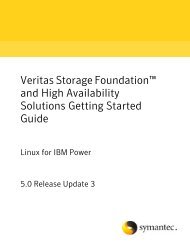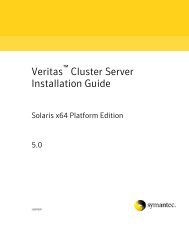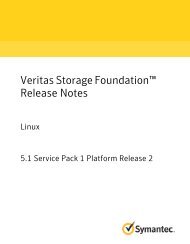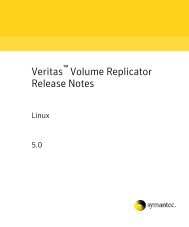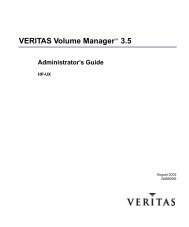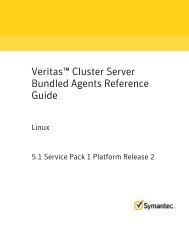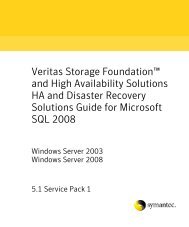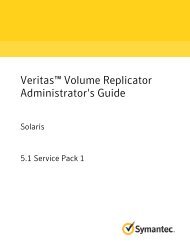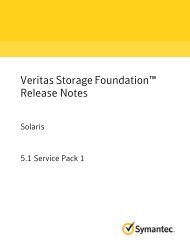Veritas Storage Foundation™ and High Availability Solutions ...
Veritas Storage Foundation™ and High Availability Solutions ...
Veritas Storage Foundation™ and High Availability Solutions ...
You also want an ePaper? Increase the reach of your titles
YUMPU automatically turns print PDFs into web optimized ePapers that Google loves.
<strong>Veritas</strong> Cluster Server: Configuring Oracle VM Server for SPARC for high availabilityAbout <strong>Veritas</strong> <strong>Storage</strong> Foundation Cluster File System in an Oracle VM Server for SPARC environment113About <strong>Veritas</strong> <strong>Storage</strong> Foundation Cluster File Systemin an Oracle VM Server for SPARC environment<strong>Veritas</strong> <strong>Storage</strong> Foundation Cluster File System (SFCFS) allows clustered serversto mount <strong>and</strong> use a file system simultaneously as if all applications using the filesystem were running on the same server for a Oracle VM Server for SPARC.<strong>Veritas</strong> <strong>Storage</strong> Foundation Cluster File System limitationsDepending on the configuration model, the following limitations apply to usingSFCFS in an Oracle VM Server for SPARC environment.Limitations for SFCFS configuration in the guest domain:■■There is no support for replicating a shared disk group using VVR, when oneor more guest domains share the disk group.If you want to configure I/O fencing in guest domain, then do not exportphysical devices to more than one guest domain on the same physical node.Otherwise, I/O fencing fences off the device whenever one of the guest domaindies. This situation causes the other guest domains also to lose access to thedevice.Symantec recommends you to disable I/O fencing if you exported the same physicaldevice to multiple guest domains.About <strong>Veritas</strong> Cluster Server configuration models inan Oracle VM Server for SPARC environmentWhen you configure VCS in an Oracle VM Server for SPARC environment, youneed some specific information about the logical domain, network, <strong>and</strong> the storagedevices that the logical domain requires to run.You need to know the following information about your logical domain:■■■■The logical domain’s nameThe names of the primary network interfaces for each nodeThe virtual switch that the logical domain usesThe name <strong>and</strong> type of storage that the logical domain usesVCS configuration depends on whether you want VCS to fail over the logicaldomain or the application on a failure:■<strong>Veritas</strong> Cluster Server setup to fail over a logical domain on a failure



